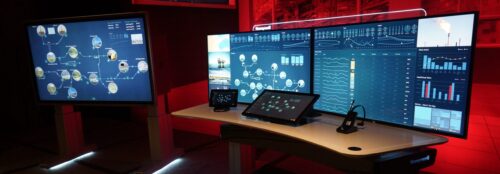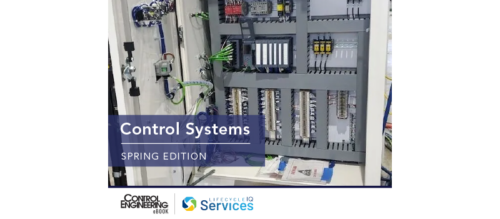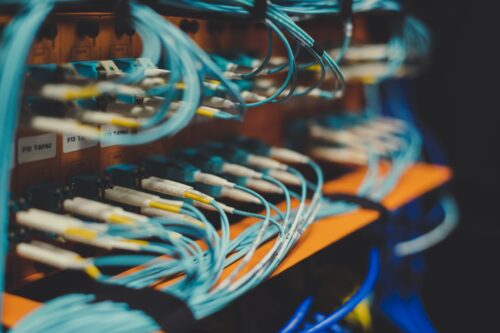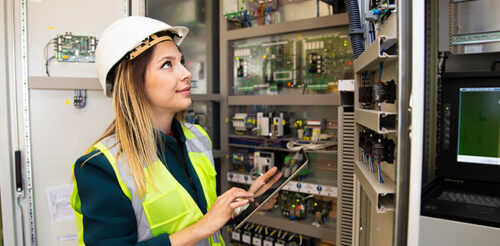Manage the Whole Process with Multivariable Control
Single-variable controllers such as PID loops are by far the most popular controllers for industrial applications. A single-variable controller measures the one and only variable of interest, decides if its value is acceptable, applies a corrective effort if necessary, then repeats. This routine works very well for process control problems with just one variable or with multiple variables...
KEY WORDS
Process control and instrumentation
Multivariable control
Advanced control
Control theory
Sidebars: Terms What Questions to Ask About Multivariable Controllers
Single-variable controllers such as PID loops are by far the most popular controllers for industrial applications. A single-variable controller measures the one and only variable of interest, decides if its value is acceptable, applies a corrective effort if necessary, then repeats. This routine works very well for process control problems with just one variable or with multiple variables that can be manipulated independently.
The problem gets much trickier when the control system is required to achieve multiple objectives using multiple actuators that each affect all of the process variables simultaneously. Such problems require multivariable controllers that can balance the actions of all the actuators all at once.
The problem gets trickier still if it is possible to meet the desired objectives with several different combinations of control efforts. The most efficient multivariable controllers can select the combination cheapest to implement. Some can also take in to account the potential cost of not applying the correct control effort. Costs can include not only financial considerations such as energy spent vs. energy saved, but safety and health factors as well.
Multivariable controllers are most common in the petrochemical, aeronautical, and energy industries. In a distillation column for example, there can be hundreds of temperatures, pressures, and flow rates that must all be coordinated to maximize the quality of the distilled product. A jet aircraft control system must coordinate the plane’s engines and flight control surfaces to keep it flying on the course dictated by the pilots.
Multivariable control techniques
So how does a multivariable controller do all this? There are just a few basic multivariable control techniques, but oddly enough, PID isn’t one of them. Neither the PID algorithm nor any of the other traditional single-variable control techniques can account for the effects of coupling . Two process variables are said to be coupled if changing one changes the other.
Most single-variable controllers also ignore the cost of applying a control effort. Their only objective is to correct deviations in the one and only process variable, regardless of the cost.
On the other hand, if control costs are in fact negligible and if the coupling is weak, then several single-variable controllers can be combined to regulate a multivariable process. The National Aeronautics and Space Administration tried this approach with some of its early spacecraft. NASA used three independent attitude controllers to regulate the spacecraft’s pitch, yaw, and roll. Each controller simply reacted to the effects of the other two as if it were handling an external disturbance. This scheme worked well enough, but the controllers tended to work against each other and ended up expending considerably more energy than necessary.
Decoupling
Single-variable controllers can also be used for multivariable applications if the process variables can be decoupled. Figure 1 shows how a simple process with two controllers (C1 and C2) and two process variables (PV1 and PV2) can be decoupled so that each controller ends up affecting only one process variable. The decouplers (D21 and D12) are designed to cancel the crossover effects (P21 and P12) that each controller has on the other process variable. The decouplers allow both controllers to operate as if each were in control of its own independent process (P1 and P2, respectively).
The simplest approach to decoupling addresses just the steady state effects of crossover. A series of open-loop step tests will show how much of an effect each controller has on each process variable. If, for example, a unit step from C1 increases PV1 by X% (via P1) and a unit step from C2 increases PV1 by another Y% (via P12), then the decoupler D12 can be set to a gain of–Y/X. The net effect that C2 will then have on PV1 during closed-loop operations will be zero.
Figure 2 shows another technique for multivariable decoupling commonly used in the chemical processing industry. Here, the decoupling is accomplished by allowing each controller to modify the other’s set-point. The setpoint for controller FC2 is set in proportion to process variable FT1. The setpoint for controller FC1 is set so that FT1 and FT2 sum to a desired value. The net result of this ratio control technique is to maintain both the sum and the ratio of the two process variables at desired values while still controlling them individually.
Limitations
Although both of these decouplers are relatively simple to design and implement, their use is limited to applications where only the steady state values of the process variables are important. If the fluctuations of the process variables must also be controlled, more elaborate decouplers that account for the dynamic behavior of the process are required.
Furthermore, even decouplers that are designed to accommodate both the dynamic and steady state effects of crossover will work only if the crossover behavior is either very weak or very well understood. Otherwise, the decouplers will be unable to negate the cross-over effects completely. Decoupling can also fail if the behavior of the process changes even slightly after the decouplers have been implemented.
Minimum variance control
A minimum variance control algorithm is generally much more effective for multivariable control. Variance is a measure of how badly a process variable has varied from its setpoint over a period of time. It is computed by periodically squaring the measured error between the two values and adding the results into a historical total. For a multivariable process, the overall variance is a weighted sum of the variances computed for each individual process variable.
A minimum variance controller coordinates all of its control efforts so as to minimize the overall variance. It can also minimize the cost of control by treating each control effort as if it were another process variable with a setpoint of zero. The weighting factors used for the overall variance calculation can be chosen to dictate how much emphasis the controller places on eliminating errors vs. minimizing control efforts. In an HVAC example, the controller can be designed to be more or less aggressive depending on the relative benefits of reducing energy expenditures vs. keeping the room’s occupants comfortable.
Minimum variance controllers often incorporate mathematical models of the process to predict the future effects of current control efforts. This advanced warning allows the controller to choose its next contol effort so as to minimize future variances between the process variables and their setpoints.
Constraints
The process model also allows the controller to impose limits or constraints on both its control efforts and the process variables. If the model is accurate, the controller can look ahead to see where its control efforts and the process variables are headed, then change course to avoid violating a constraint in the future. However, if the model does not accurately reflect the behavior of the process, the constraints may be violated anyway.
Constraints represent the physical limitations of the process. For example, valves can not be opened more than 100% and mechanical actuators can not be moved so fast that they destroy themselves. Some process variables must also be constrained to remain close to their setpoints, no matter what the cost. Overshooting the setpoint may be the fastest way to achieve the desired temperature in an oven, but it may also incinerate the product inside.
Satisfying such constraints is one of the principal motivations for implementing minimum variance control. Figure 3 shows how variance effects the choice of a process variable’s setpoint. If the controller can successfully minimize the variance of the process variable, the setpoint can be moved much closer to the nearest constraint. This allows the process to operate at the very edge of its physical limits, thus maximizing its productivity.
Unfortunately, the benefits of minimum variance, model predictive, and most other forms of multivariable control come at a price. The mathematical formulation of even the simplest of these algorithms is tedious and much more complex than PID theory. It’s no wonder that the PID algorithm remains the champion of all control techniques.
Terms
Actuators —devices that can influence the behavior of a process and thereby cause a change in the process variables.
Constraints —the highest and lowest values allowable for a process variable.
Control efforts (or corrective effortsor controller outputs or manipulated variables or process inputs) —commands that the controller sends to the actuators in order to drive the process variables towards their respective setpoints.
Coupling —physical phenomena that cause several process variables to react to the efforts of a single actuator.
Decoupling —a control technique that allows a multivariable controller to manipulate each process variable independently.
Disturbances(or process disturbances) —-uncontrollable phenomena that can influence the process and cause the process variables to depart from their setpoints unexpectedly.
Model —a set of mathematical relationships that show how the values of the process variables depend on the controller’s efforts and process disturbances.
Minimum variance control —a control technique that attempts to minimize the sum of the squared errors between a process variable and its setpoint.
Model predictive control —a multivariable control strategy that depends on a mathematical model to predict the future effects of current control efforts.
Multivariable controller —a computer system that measures several process variables and attempts to correct their values with several coordinated actuators that each affect more than one process variable.
Nonlinear process —a process that becomes more or less sensitive to control efforts as the process variables fluctuate.
Pairing —A step in the design of a multivariable controller where each actuator is associated with the process variable that it affects the most.
PID control —a single-variable control technique that generates its control efforts according to the proportional-integral-derivative algorithm (see “Basics of Proportional-Integral-Derivative Control,” CE , March 1998).
Process (orcontinuous process) —a physical system that turns raw materials into a desired product when its operating conditions are maintained at specified levels.
Process variables (or controlled variables or process outputs) – measurable quantities that indicate the current conditions or behavior of the process.
Ratio control —a multivariable control technique that attempts to maintain the ratio of two process variables at a desired value.
Setpoints —the desired values for the process variables.
Single-variable controller (or single-loop controller) —a computer system that measures a single process variable and uses a single actuator to generate corrective efforts.
Step tests —experiments conducted during the commissioning of a control system to determine how the process variables react to abrupt changes in their respective setpoints or to abrupt changes in the controllers’ outputs.
Variance —a measure of how much a process variable fluctuates around its setpoint.
What Questions to Ask About Multivariable Controllers
Thousands of multivariable control techniques have been developed for specific applications. Each has its advantages, but none is ideal in every situation (see “Multivariable Controllers Enter the Mainstream,” CE, March 1997). Here are some of the issues that distinguish one from another.
Technology questions
What assumptions does the controller make about the behavior of the process? Does the controller rely on a mathematical model of the process?
Can the controller automatically update process model and improve the quality of its control efforts while continuing to operate in closed loop?
How are the controller’s economic objectives specified? Can a separate cost be assigned to each process variable? Can the cost of moving an actuator be figured into the controllers decision-making process as well?
Can the controller automatically compute the setpoints that will maximize productivity and minimize costs?
Can the controller be configured to keep its actuator moves and the process variables constrained within allowable ranges? Can the constraints be prioritized so that the controller works hardest to constrain the most critical variables? Can the constraints on the actuator moves be prioritized as well?
What happens when a sensor fails or an actuator saturates? Can the controller continue to regulate the process by shifting its attentions to the remaining sensors and actuators?
Can the controller handle measurements taken at random intervals (such as the results of a lab analysis)?
What does the controller do if it is given a set of objectives physically impossible to meet?
What happens if the behavior of the process changes after the controller has been commissioned? What happens if the process is nonlinear so that its behavior changes as the process variables fluctuate?
Can the controller decouple the process variables?
Technique questions
How many variables can the controller handle?
How do operators tune the controller’s performance? Can the controller be tuned to reject disturbances, track setpoints, or both?
How much information about the process must the operators specify when first commissioning the controller? How is that information collected?
How is the process model created and validated?
Can the controller collect any modeling information automatically? What stimulation must the controller apply to the process to collect the required information?
Must the operator specify which actuator has the greatest effect on each process variable, or can the controller perform such pairings automatically?
On what computing platform does the control algorithm run? Can any of it be run off-line? What options are available for interfacing the computing platform to the process?
Can the operators manually adjust the process model? What tools are available to facilitate manual adjustments?
Can the process model, the setpoints, and performance objectives be changed on-line? Must the setpoints remain constant or can they be configured to follow a desired trajectory? Can the setpoints and the performance objectives be manipulated by other programs?
Can the performance of the controller be tested off-line with a simulation facility? What sort of “what-if” scenarios can the operators test?
Must the controller be implemented by experts or can the operators perform the necessary configuration and tuning functions themselves? What support services are available from the vendor?
Do you have experience and expertise with the topics mentioned in this content? You should consider contributing to our CFE Media editorial team and getting the recognition you and your company deserve. Click here to start this process.





